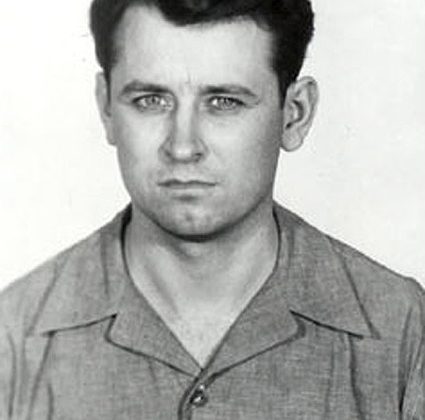
Table Of Contents
Who is James Earl Ray?
On April 4th, 1968, Dr. Martin Luther King Jr., a civil rights activist and Nobel Laureate, was assassinated by James Earl Ray on the balcony of the Lorraine Motel in Memphis, Tennessee. In this blog post, we’ll learn who James Earl Ray was, what role he played in the MLK assassination, and learn more about the man who killed Martin Luther King.
Early Life
James Earl Ray was born into a poor family on March 10th, 1928, as the oldest of nine children in Alton, Illinois. His mother, Lucille Ray, had his siblings John, Franklin, Jerry, Melba, Carol, Suzan, and Marjorie. His sister Marjorie died in a fire aged 4 in 1933 after catching herself on fire from playing with matches.
In February of 1935, Ray’s father was arrested for passing a bad check in Alton. After he got caught passing the bad check, he moved his family to Ewing, Missouri, and changed their last name from ‘Ray’ to ‘Raynes.’
Shortly after, he dropped out of school at the age of 12. At 16 years old, Ray left his parents and moved in with his grandmother back in Alton. He soon got a job at the International Shoe Tannery.
Military Life
After being fired from the Tannery, James enlisted in the Army at the close of World War 2, getting stationed in West Germany. He found the military regiment’s strict codes of conduct difficult to adjust to. He was punished for drunkenness and breaking arrest before getting discharged for ineptitude and lack of adaptability in 1948.
Ray’s post-Army life proved just as unstable as his time in the service.
Life Of Crime
In 1949, when James Earl Ray was 21 years old, he left for Los Angeles. One October night, soon after arriving in LA, police arrested him and sent him to prison for 90 days because of a cafe burglary charge which would later become a suspended sentence.
He became a career criminal and committed numerous crimes over the following years, serving different jail sentences. In 1952, James Earl Ray spent two years in prison for armed robbery of a taxi in Illinois. Just three years later, he was convicted of mail fraud and served four years in Leavenworth after stealing money orders in Hannibal, Missouri, to take them on a trip to Florida.
The most serious of his crimes came in 1959 when on parole for an earlier theft, he robbed two St. Louis grocery stores and another in Alton. He was caught in an armed robbery stealing $120 from a Kroger store in St. Louis. After this, Ray was sentenced to twenty years in prison for repeated offenses.
Prison Time
He got his first taste of prison life after joining the Army and getting sent to Germany following World War II. James liked to drink and got himself arrested on a drunk and disorderly charge. When he got out of the service, he began drifting around and spending a few nights in jail for vagrancy. His first big arrest came in 1949, and he served eight months in a California jail for burglary.
In March 1960, he started a 20-year sentence for his repeated offensives and crimes at the Missouri State Penitentiary. His time served was cut short, however.
Prison Break
Ray managed to escape the facility in April of 1967 by hiding in a truck transporting bread from the prison bakery. After his escape, Ray remained on the move throughout the United States and Canada. His first stop was St. Louis, before going to Chicago, Toronto, Montreal, and Birmingham. He purchased a 1966 Ford Mustang in Birmingham and obtained an Alabama driver’s license. He then drove to Mexico, living first in Acapulco before relocating to Puerto Vallarta on October 19th, 1967.
Life After Prison Break
While in Mexico, James Earl Ray began to use the Alias “Eric Starvo Galt. He tried to become a pornographic film director by filming and photographing local prostitutes. This was wildly unsuccessful, leading him to leave Mexico on or around November 16th, 1967.
Ray then returned to the USA, arriving in Los Angeles on November 19th, 1967. His main interest in this period was the George Wallace presidential campaign. James Earl Ray was a racist and quickly drawn to Wallace’s segregationist platform. He spent many hours volunteering at the campaign headquarters in North Hollywood.
He considered moving to Rhodesia (now known as Zimbabwe), a country with a predominantly white minority government. His desire for living in a white-ruled country continued to grow even long after Dr. King’s assassination.
Time Before Dr. King’s Murder
Ray underwent a facial reconstruction to change his appearance to avoid being recognized by authorities. The surgery was performed on March 5th, 1968. It was so successful that he couldn’t be easily recognized even when the FBI eventually interviewed him under his new identity of Ramon George Sneyd years later. In 1968, Ray left Los Angeles and began a cross-country drive to Atlanta, Georgia, on March 18th, 1968.
After arriving in Atlanta, Georgia, on March 24th, 1968, he checked into a rooming house and bought a city map. FBI agents eventually find this map when they searched his motel room. This map was circled to show the church and residence of civil rights movement leader Martin Luther King Jr.
James Earl Ray passed the time by reading articles about the civil rights leader Martin Luther King Jr. in The Atlanta Constitution. This paper reported King’s planned return trip to Memphis, TN, scheduled for April 1st, 1968. On April 2nd, 1968, Ray packed a bag and drove alone to Memphis.
Assassination Of Martin Luther King Jr.
On April 4th, 1968, James Earl Ray stood in the bathroom bathtub, balancing his Remington rifle on the ledge of a window, and fatally shot King as the civil rights leader was standing on the second-floor balcony outside of his Lorraine motel room.
Shortly after the shot was fired, eyewitnesses saw James fleeing from a rooming house across the street from the motel; he had been renting a room in the house at the time. A package obtained by the Memphis police near the area where King was shot found to have been abandoned. It included a rifle and binoculars that both had Ray’s fingerprints on them.
After he shot Martin Luther King Jr., Ray fled immediately, setting off an international hunt that lasted more than two months and covered five countries. It was said to be the FBI’s most expensive and biggest investigation in the history of all federal government agencies at that time.
Apprehension & Confession
After shooting Dr. King, Ray drove eleven hours north to Canada, where he hid for over a month before acquiring Canadian passports under Ramon George Sneyd’s alias name. He left Toronto in late May on a flight to England. He stayed briefly in Lisbon, Portugal, and returned to London.
On June 8th, 1968, two months after King’s death, he was arrested at London Heathrow Airport, attempting to leave the UK for Brussels on a false Canadian passport. He was trying to depart the UK for Angola, Rhodesia, or apartheid South Africa. When checking in, the airline noticed his name, Sneyd, on a Royal Canadian Mounted Police watchlist.
Officials at the airport noticed that James Earl Ray had another Canadian passport under a different name. The UK quickly extradited him to Tennessee, where he was charged with King’s murder. He confessed on his 41st birthday, and after he pleaded guilty, he was sentenced to 99 years in prison.
Confession Reversal
Just three days after Earl Ray pleaded guilty, he recanted his confession despite extensive evidence. James originally pled guilty plea on the advice of his attorney, Percy Foreman, to avoid the sentence of death by electrocution. However, since 1967 and following Furman v. Georgia, a death sentence would have been commuted as unconstitutional under the de facto moratorium.
Ray began claiming that a man he met in Montreal in 1967, who used the alias “Raul,” had been deeply involved. He asserted that it was not himself who “personally shot Dr. King” but was “partially responsible without knowing it,” which hinted to a conspiracy that he did not kill King for financial gain. Ray told this version of King’s assassination and his flight in the two months afterward to journalist William Bradford Huie.
Investigation Of Conspiracy
Huie investigated this story to determine ray’s innocence and discovered that James Earl lied about some details. He told Huie that he left the rifle with his fingerprints on them because becoming a famous criminal was a goal of his.
Upon investigation, police would discover that Harvey Lowmeyer purchased the gun in Birmingham, AL, on March 30th, only five days before the shooting.
He believed that the Governor of Alabama, George Wallace, would soon be elected president and only be confined for a short time.
He then spent the remainder of his life unsuccessfully attempting to withdraw from pleading guilty and securing a new trial. This drew the ire of many of King’s family.
Second Prison Break
On June 10th, 1977, James and six other convicts escaped from Brushy Mountain State Penitentiary in Petros, Tennessee. They were recaptured on June 13th. A year was added to his previous 99-year sentence, making it an even 100 years. In 1997 King’s son Dexter King visited Ray in prison to draw attention to the family’s push to appeal his case.
How Did James Earl Ray Die?
James died at Columbia Nashville Memorial Hospital in Nashville, Tennessee, on April 23rd, 1998, from complications caused by hepatitis C. Ray had been treated for liver disease over the years. According to the Tennessee Department of Correction, the cause of death was kidney failure.
Is James Earl Ray Still Alive?
No, James died on April 23rd, 1998. His cause of death was listed as kidney failure.
The King Family After Ray’s Death
Even after Ray died, the family, including Coretta King, continued to say that there was “overwhelming evidence that identified someone else, not James Earl Ray, as the shooter, and that Mr. Ray was set up to take the blame.” The King family’s belief in Ray’s innocence was partly influenced by the strange case of Loyd Jowers, who’d owned the restaurant below Ray’s rented room in Memphis.

Leave a Reply